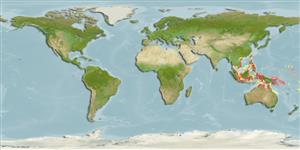>
Gobiiformes (Gobies) >
Gobiidae (Gobies) > Gobiinae
Etymology: Eviota: No etymology given, suggested by Christopher Scharpt: from Latin 'eu' for 'true' and 'iota' for anything very small, in combination 'truly very small' referring to it as being the smallest vertebrate at the time it has benn described by Jenkins (thus, making the suggestion by Scharpt plausible; winterbottomi: Named for Richard Winterbottom; noun in genitive case.
Eponymy: Dr Richard ‘Rick’ Winterbottom (d: 1944) is an evolutionary biologist and ichthyologist who was born in Zambia. [...] (Ref. 128868), visit book page.
More on authors: Greenfield & Randall.
Environment: milieu / climate zone / intervalo de profundidade / distribution range
Ecologia
marinhas associadas(os) a recifes; intervalo de profundidade 0 - 30 m (Ref. 83982). Tropical
Western Pacific: Vietnam, Indonesia and Palau.
Tamanho / Peso / Idade
Maturidade: Lm ? range ? - ? cm
Max length : 1.6 cm SL macho/indeterminado; (Ref. 83982); 1.6 cm SL (female)
Descrição breve
Chaves de identificação | Morfologia | Morfometria
Espinhos dorsais (total) : 7; Raios dorsais moles (total) : 8; Espinhos anais: 1; Raios anais moles: 8. This species is distinguished from its congeners by the following set of characters: dorsal/anal fin-ray formula 8/8; branched pectoral fin rays 6-7; cephalic sensory-pore system pattern I (complete); absence of fifth segmented pelvic-fin ray; branches on fourth pelvic-fin ray 3-6; non-fimbriate genital papilla; non-filamentous first dorsal fin; slender body 18.8-23.6% SL; spindle-shaped black lines on body (from black pigment in scale-pocket tissue); pigmented anal fin; ventral surface of caudal peduncle with 3 dark marks, 2 more on anal-fin base in preserved specimens; when fresh, 6 internal black blotches on sides (Ref. 83982).
Body shape (shape guide): elongated.
Collected with rotenone and quinaldine (Ref. 83982). Inhabits coral reef crevices in 2-30 m (Ref 90102).
Life cycle and mating behavior
Maturidade | Reprodução | Desova | Ovos | Fecundidade | Larvas
Greenfield, D.W. and J.E. Randall, 2010. Four new gobiid fishes of the genus Eviota from the Western Pacific, with clarification of Evoita guttata and Evoita albolineata (Teleostei: Goblidae). Proc. Calif Acad. Sci. 61(3):269-289. (Ref. 83982)
Categoria na Lista Vermelha da IUCN (Ref. 130435: Version 2025-1)
Ameaça para o homem
Harmless
Utilização humana
Ferramentas
Relatórios especiais
Descarregue XML
Fontes da internet
Estimates based on models
Preferred temperature (Ref.
123201): 28 - 29.2, mean 28.8 °C (based on 791 cells).
Phylogenetic diversity index (Ref.
82804): PD
50 = 0.5000 [Uniqueness, from 0.5 = low to 2.0 = high].
Bayesian length-weight: a=0.00692 (0.00284 - 0.01683), b=3.10 (2.92 - 3.28), in cm total length, based on LWR estimates for this Genus-body shape (Ref.
93245).
Nível Trófico (Ref.
69278): 3.0 ±0.3 se; based on size and trophs of closest relatives
Fishing Vulnerability (Ref.
59153): Low vulnerability (10 of 100).
🛈
